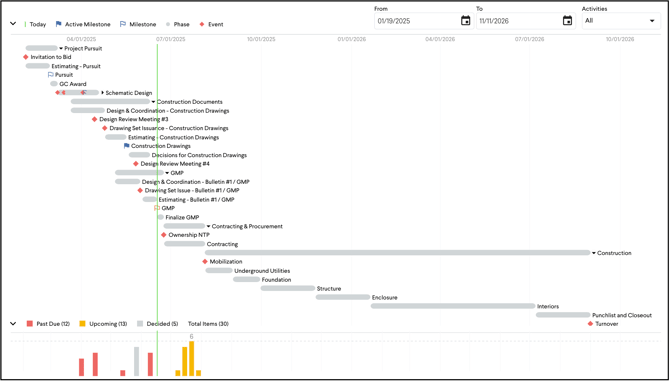Why Showcase a Timeline in Join?
Create a single source of truth to keep your team aligned on key dates, milestones, and deliverables.
Building out a timeline in Join gives your team a clear, shared view of how your project is expected to unfold. It keeps everyone aligned on upcoming activities, milestones, and responsibilities, reducing confusion, avoiding delays, and helping your team focus on the right work at the right time.
Use the Timeline to:
- Align around upcoming activities and deliverables
- Manage decision volume more effectively
- Avoid the cost of delayed decisions

Align Around Upcoming Activities and Deliverables
Provide your team with a centralized view of what’s ahead.
Build a Timeline with key events such as drawing issuances, design reviews, or meetings. Highlight important milestones or targets like GMP estimate or permit approvals, so the entire team knows what’s coming and when.
Tip: Dates in Join are flexible. Don’t wait for perfect information to get started. Use placeholders for target dates to set expectations early, and add dependencies (predecessors or successors) in the Workspace view to make updates faster and easier as plans evolve.
Manage Decision Volume
When too many decisions accumulate at once, your team can become overwhelmed. The Timeline helps spread the decision-making workload across time, making it easier to manage and resource appropriately.
Set Due Dates on Items to populate the Item Distribution Chart. Visualize how decision volume is distributed, and identify any bottlenecks or Items that are falling behind.

To plan ahead, link Items directly to Events like upcoming OAC meetings. This turns your Timeline into a living agenda, helping you focus conversations and drive decisions forward with intention.

Tip: Add Due Dates and Events from the Item detail page to activate smarter planning and visibility across Timeline.
Avoid the Cost of Delayed Decisions
Preconstruction is full of decisions that impact cost, scope, and schedule. Delayed decisions during this phase can ripple into construction, leading to expensive consequences like overtime, rework, or expediting.
The Timeline helps you stay ahead by making it clear what needs to be decided and by when. Use it to track key items, align on deadlines, and keep decision-making moving so nothing critical falls through the cracks.
Tip: Use Item Due Dates to define the “last responsible moment”—the latest point a decision can be made without impacting downstream work. This gives your team flexibility while keeping the project on track.